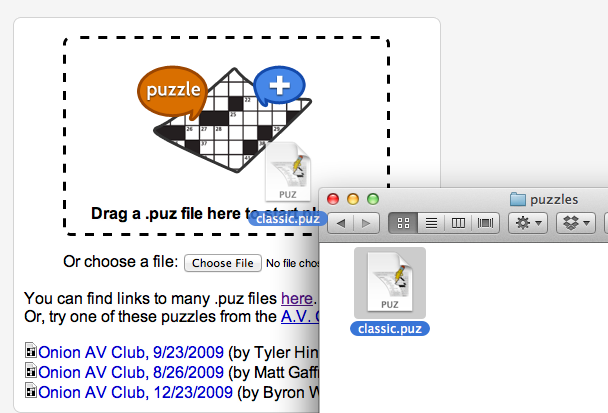05.21.12
Posted in personal at 2:45 pm by danvk
 I recently found a disk image I made from an old, circa 1997 hard drive. Back then we used ClarisWorks for all of our word processing needs. I quickly ran into my own version of the Digital Dark Age: how to read these ancient files? I spent enough time figuring this out that I owe it to the web to write up the process.
I recently found a disk image I made from an old, circa 1997 hard drive. Back then we used ClarisWorks for all of our word processing needs. I quickly ran into my own version of the Digital Dark Age: how to read these ancient files? I spent enough time figuring this out that I owe it to the web to write up the process.
Read the rest of this entry »
Permalink
05.17.12
Posted in programming, web at 8:48 am by danvk
To solve a crossword with your friends in Google+, click this giant hangout button:

You’ll see something like this:

Click “Hang out” to invite everyone in your circles to help you with the puzzle. If you want to collaborate with just one or two people, click the “x” on “Your Circles” and then click your friend’s names on the right.
You’ll be prompted to either upload a .puz file or play one of the built-in Onion puzzles. You can get a free puzzle from the New York Times by clicking “Play in Across Lite” on this page.
With the puzzle downloaded, drag it into the drop area:

And now you’re off to the races! The big win of doing this in a Google+ hangout is that you get to video chat with your collaborators while you’re solving the puzzle, just like you would in person!

Astute readers will note that puzzle+ is a revival of lmnopuz for Google Shared Spaces, which was a revival of lmnowave (Crosswords for Google Wave), which was in turn a revival of Evan Martin and Dan Erat‘s standalone lmnopuz. Hopefully the Google+ Hangouts API will be more long-lived than its predecessors.
Permalink
05.14.12
Posted in programming, web at 10:04 am by danvk
I recently wanted to center some content both vertically and horizontally on a web page. I did not know in advance how large the content was, and I wanted it to work for any size browser window.
These two articles have everything you need to know about horizontal centering and vertical centering.
The two articles don’t actually combine the techniques, so I’ll do that here.
In the bad old days before CSS, you might accomplish this with tables:
<table width=100% height=100%>
<tr>
<td valign=middle align=center>
Content goes here
</td>
</tr>
</table>
Simple enough! In the wonderful world of HTML5, you do the same thing by turning divs into tables using CSS. You need no fewer than three divs to pull this off:
<div class="container">
<div class="middle">
<div class="inner">
Content goes here
</div>
</div>
</div>
And here’s the CSS:
.container {
display: table;
width: 100%;
height: 100%;
}
.middle {
display: table-cell;
vertical-align: middle;
}
.inner {
display: table;
margin: 0 auto;
}
A few comments on why this works:
- You can only apply
vertical-align: middle to an element with display: table-cell. (Hence .middle)
- You can only apply
display: table-cell to an element inside of another element with display: table. (Hence .container)
- Elements with
display: block have 100% width by default. Setting display: table has the side effect of shrinking the div to fit its content, while still keeping it a block-level element. This, in turn, enables the margin: 0 auto trick. (Hence .inner)
I believe all three of these divs are genuinely necessary. For the common case that you want to center elements on the entire screen, you can make .container the body tag to get rid of one div.
In the future, this will get slightly easier with display: flexbox, a box model which makes infinitely more sense for layout than the existing CSS model. You can read about how do to horizontal and vertical centering using flexbox here.
Permalink
 I recently found a disk image I made from an old, circa 1997 hard drive. Back then we used ClarisWorks for all of our word processing needs. I quickly ran into my own version of the Digital Dark Age: how to read these ancient files? I spent enough time figuring this out that I owe it to the web to write up the process.
I recently found a disk image I made from an old, circa 1997 hard drive. Back then we used ClarisWorks for all of our word processing needs. I quickly ran into my own version of the Digital Dark Age: how to read these ancient files? I spent enough time figuring this out that I owe it to the web to write up the process.


